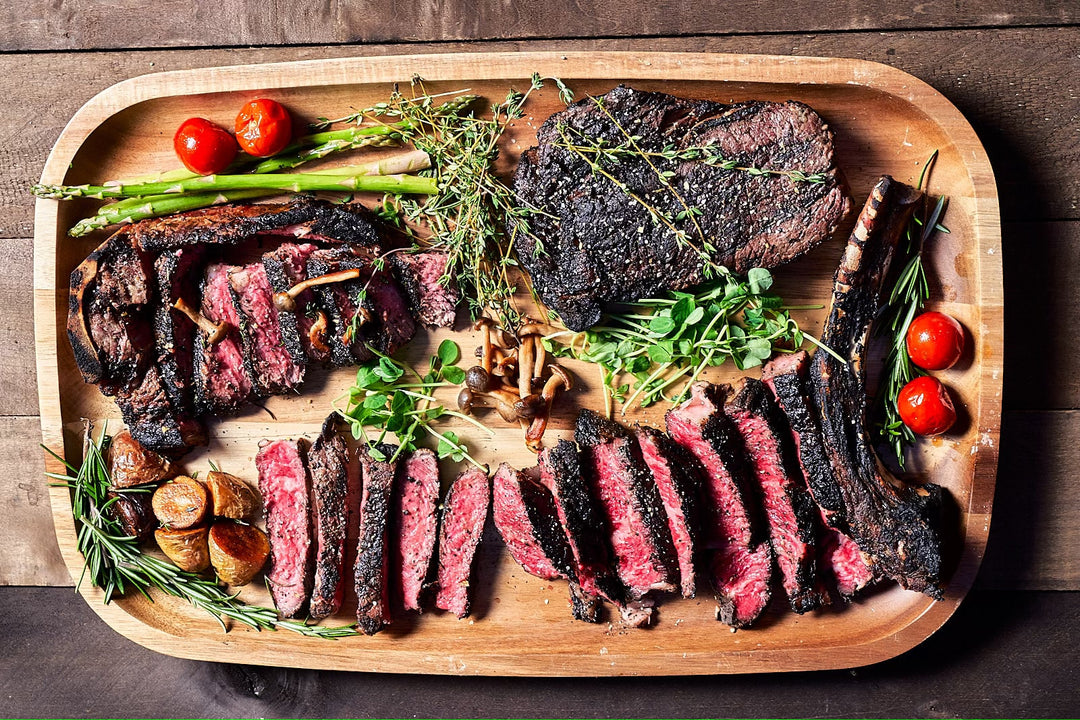New York Strip vs. Ribeye Steaks
When it comes to steak, few cuts rival the classic New York Strip and Ribeye. Menus and grills across the globe feature these two steakhouse favorites due to their tenderness, flavor, and unique qualities. Mr. Steak compares these two heavyweights to discover who comes out on top of Ribeye vs New York Strip.
Appearance and Location on the Cow:
The first distinction between these two cuts lies in their appearance and the location on the cow from which they're sourced.

The New York Strip is noticeable by its strip shape with a rim of fat running down one edge. This fat is thick and tougher to get through but still adds to the overall flavor. The rest of the NY Strip is a leaner cut with less marbling that the ribeye, giving it the distinct texture it's famous for.
The butcher cuts the New York Strip from the cow's "Short Loin", where the tenderloin and top loin meet. The Short Loin of the cow lies behind the rib section and extends towards the rear. The NY Strip comes from one side of the bone of a Porterhouse or T Bone steak.

The Ribeye is identifiable by it's immense marbling and ribeye cap running around the outside of the cut. A thick ring of fat separates the cap from the eye of the ribeye. The marbling gives it a greater fat content than other steak cuts, making it so flavorful, juicy, and tender.
The butcher cuts the Ribeye from the cow's "Primal Rib" or "Rib". They then slice the larger Prime Rib cut into individual steaks - the Ribeye. The name comes from the central and best tasting part of the rib section, known as the "eye"
Sections of cuts from a Cow:

Tenderness and Flavor:
Tenderness and flavor are often the ultimate deciders when choosing the New York Strip Steak vs Ribeye.
The New York Strip, though slightly less marbled than the Ribeye, makes up for it with unique texture. The tougher texture carries with it a subtle beefy flavor. This is a go-to option for those who appreciate a leaner cut that still offers a savory steak experience.
The Ribeye's reputation comes from its abundant marbling that melts during cooking. This saturates the meat with rich flavors and ensures tenderness in every bite. The Ribeye is perfect when you are looking to indulge in a melt-in-your-mouth dinner that leaves you satisfied.
The biggest contributor to tenderness and flavor is the quality and preparation of the steaks. USDA Prime are the highest quality steaks, followed by Choice and Select - Mr. Steak explains more here. You should season and allow the steaks to reach room temperature before cooking. This will give you the best possible steak experience.
Bone-In vs. Boneless:
An additional factor to consider is whether you prefer your steak bone-in or boneless.
The New York Strip can be bone-in, also known as a Kansas City Strip, or boneless. The Ribeye can also be bone-in or boneless, with many variations of the bone-in. The classic bone-in Ribeye's picture-perfect appearance around the world. The iconic Tomahawk and Cowboy Ribeyes have the bone sticking out for aesthetics are are normally much thicker cuts.


The bone can act as a heat conductor to help cook the steak evenly. Some believe the bone marrow adds to the overall flavor of the steak as it cooks. Mr. Steak put boneless and bone-in head-to-head to find out the truth. It's up to you choose what you prefer - the bone-enhanced presentation or the easy to slice boneless.
Cooking:
The battle between these two cuts doesn't end with their origin or flavor; it extends to the realm of grilling techniques. Always season for at least 45 minutes and allow the steak to reach room temperature before cooking. Mr. Steak always recommends grilling on high heat and allowing the grill to preheat as much as possible.
The New York Strip's leaner nature makes it a superb candidate for grilling. Its lower fat content reduces the risk of flare-ups while cooking, allowing for a satisfying sear without excessive charring. Cooking time depends on your desired doneness. You can achieve that perfect medium-rare to medium level (internal temperature ~135°F) with a nice charred outside.

The Ribeye, with its higher fat content, requires a slightly different approach on the grill. The marbling that defines the Ribeye's flavor profile can lead to flare-ups if not managed properly. To lock in the juices and create a mouthwatering crust, we recommend searing the Ribeye over high heat.

After searing the steak, you should move it to indirect heat on the grill, or lower the heat. This will help prevent excessive charring and uneven cooking. This method allows the fat to render and infuse the meat with it's distinctive flavor. This gives the Ribeye it's juicy, tender, and delicious flavor.
Always allow the steak to sit for 4-6 minutes after cooking to allow for the juices to settle. This lets the steak finish cooking internally and develop it's full flavor.
The Verdict:
Choosing between Ribeye steak vs New York Strip ultimately boils down to personal preferences.
Are you drawn to the lean tenderness and subtle flavors of the New York Strip? Or does the marbling-rich, intensely flavorful Ribeye have your heart?
Do you prefer the convenience of boneless cuts or the extra succulence offered by bone-in variations?
Both the New York Strip an Ribeye are delicious steaks, you can't go wrong with either. They will satisfy your taste buds and fulfill your meat cravings, it doesn't matter which you choose. So, fire up the grill, select your cut, and embark on a culinary adventure that's sure to delight your taste buds.
Try Mr. Steak's USDA Prime New York Strip or Bone-In New York Strip
Try Mr. Steak's USDA Prime Boneless Ribeye or Bone-In Ribeye

















Leave a comment